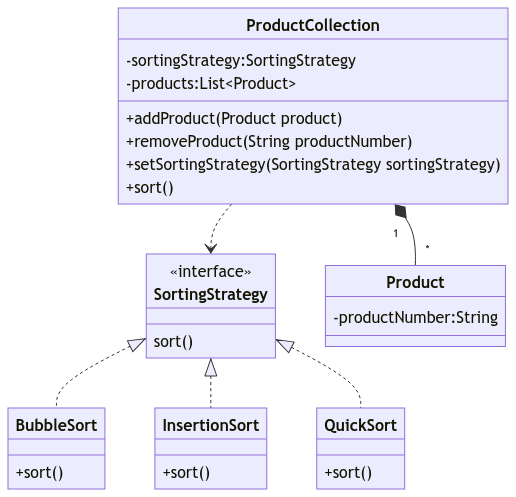The Strategy Pattern in Software Development is a design principle that isolates algorithms, referred to as “strategies,” from the specific class in which they operate, known as the “context class.” By creating individual classes for each algorithm, the Strategy Pattern offers significant benefits:
- Enhanced Flexibility: It allows for the seamless addition of new algorithms without altering the existing structure of the context class.
- Improved Reusability: By encapsulating strategies within their own classes, they become more reusable across different parts of the application.
This approach not only promotes cleaner code but also enhances the maintainability and scalability of the system, making it a valuable tool in modern software development.
Example: Sorting a collection
Suppose we have a ProductCollection class containing a collection of Product objects we want to sort. We can implement the strategy pattern by extracting the sorting algorithms from the ProductCollection class and creating different classes for each algorithm: BubbleSort, InsertionSort, and QuickSort.
The ProductCollection class should have methods like addProduct(Product product) and removeProduct(String productNumber) to add and remove products from the collection. To sort the collection, we can create a method for each sorting algorithm, such as sortWithBubbleSort(), sortWithInsertionSort(), and sortWithQuickSort().
Initially, this is what ProductCollection looks like.

Read more about
ProductCollection without Strategy Pattern
// Product class (replace with your actual implementation)
class Product {
private String productNumber;
// Other product attributes and methods...
}
// ProductCollection class
class ProductCollection {
private List<Product> products;
public ProductCollection() {
this.products = new ArrayList<>();
}
public void addProduct(Product product) {
products.add(product);
}
public void removeProduct(String productNumber) {
products.removeIf(product -> product.getProductNumber().equals(productNumber));
}
public void sortWithBubbleSort() {
// Implement Bubble Sort algorithm here
}
public void sortWithInsertionSort() {
// Implement Insertion Sort algorithm here
}
public void sortWithQuickSort() {
// Implement Quick Sort algorithm here
}
}
Suppose we have other collections in our application, such as a CustomerCollection and an OrderCollection, which also requires sorting functionality. Without the strategy pattern, we would have to duplicate the sorting algorithms in each of these classes, leading to code duplication and maintenance issues.
By using the strategy pattern, we can create separate classes for each sorting algorithm, such as BubbleSort, InsertionSort, and QuickSort, and reuse them across multiple classes. This makes our code more modular and easier to maintain. If we need to add a new sorting algorithm or update an existing one, we only need to modify the sorting algorithm class, and the change will be reflected in all classes that use that algorithm.
This approach also allows us to easily swap out one sorting algorithm for another in any of our collections without affecting the others. For example, if we decide to use QuickSort instead of BubbleSort in our CustomerCollection, we can simply replace the BubbleSort object with a QuickSort object, and the sort method will still work as expected.
Overall, the strategy pattern provides a flexible and reusable way to implement complex algorithms in our codebase.
Implementing Strategy Pattern

Below is a simplified Java implementation of the ProductCollection class with the strategy pattern:
// SortingStrategy interface
interface SortingStrategy {
void sort(List<Product> products);
}
// BubbleSort class
class BubbleSort implements SortingStrategy {
public void sort(List<Product> products) {
// Implement Bubble Sort algorithm here
}
}
// InsertionSort class
class InsertionSort implements SortingStrategy {
public void sort(List<Product> products) {
// Implement Insertion Sort algorithm here
}
}
// QuickSort class
class QuickSort implements SortingStrategy {
public void sort(List<Product> products) {
// Implement Quick Sort algorithm here
}
}
// ProductCollection class with Strategy Pattern
class ProductCollection {
private List<Product> products;
private SortingStrategy sortingStrategy;
public ProductCollection() {
this.products = new ArrayList<>();
}
public void addProduct(Product product) {
products.add(product);
}
public void removeProduct(String productNumber) {
products.removeIf(product -> product.getProductNumber().equals(productNumber));
}
public void setSortingStrategy(SortingStrategy sortingStrategy) {
this.sortingStrategy = sortingStrategy;
}
public void sort() {
sortingStrategy.sort(products);
}
}Usage Example
Here’s how you can use the ProductCollection class with different sorting strategies:
ProductCollection productCollection = new ProductCollection();
productCollection.addProduct(new Product("P1"));
productCollection.addProduct(new Product("P2"));
// Using BubbleSort
productCollection.setSortingStrategy(new BubbleSort());
productCollection.sort();
// Using QuickSort
productCollection.setSortingStrategy(new QuickSort());
productCollection.sort();When to Use the Strategy Pattern
The Strategy Pattern in Software Development is a powerful design pattern that can be applied in various scenarios. Here’s when you might consider using it:
- Multiple Algorithms for a Task: If a class has multiple ways to perform an operation, and you want to switch between these methods at runtime, the Strategy Pattern can encapsulate each algorithm and make them interchangeable.
- Code Reusability: When different parts of your application require the same behavior or algorithm, encapsulating this logic within a strategy class allows you to reuse it across different contexts, reducing code duplication.
- Need for Flexibility: If you anticipate the need to add new algorithms or modify existing ones frequently, the Strategy Pattern allows you to do so without altering the classes that use them. This makes the codebase more maintainable and adaptable to changes.
- Compliance with Open/Closed Principle: The Strategy Pattern helps you adhere to the Open/Closed Principle, which states that software entities should be open for extension but closed for modification. By defining a family of algorithms and encapsulating them within strategy classes, you can easily extend the functionality without modifying the existing code.
- Complex Conditional Logic: If a class contains complex conditional logic to choose between different algorithms, encapsulating these algorithms within separate strategy classes can simplify the code and make it easier to understand and maintain.
- Testing and Isolation: By encapsulating algorithms within strategy classes, you can isolate the behavior and make it easier to test. This promotes a cleaner codebase and facilitates unit testing.
Example Scenarios
- Sorting Algorithms: As demonstrated in the tutorial, if you have different sorting algorithms and want to switch between them at runtime, the Strategy Pattern is an ideal choice.
- Payment Processing: If an e-commerce application supports multiple payment methods (e.g., credit card, PayPal, bank transfer), the Strategy Pattern can encapsulate each payment method into separate classes, allowing easy switching and extension.
- Compression Algorithms: In a file management system, you might have different compression algorithms (e.g., ZIP, RAR, TAR). Using the Strategy Pattern, you can easily switch between these algorithms without changing the code that performs the compression.
Conclusion
The Strategy Pattern in Software Development is not a one-size-fits-all solution, and it may not be suitable for every situation. However, when faced with the scenarios described above, it offers a robust and flexible approach to managing algorithms and behaviors. By understanding the specific needs and structure of your codebase, you can determine whether the Strategy Pattern is the right choice for your application.
